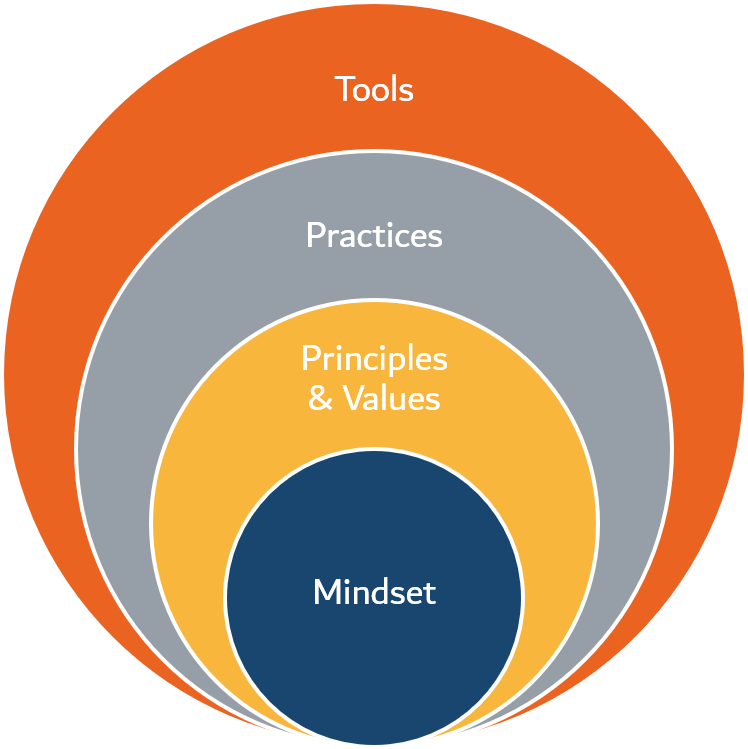Agile - A Proper Introduction

“If you meet the Buddha on the road, kill him” – Zen Proverb
Agile has become a buzzword of sorts in management and leadership circles as of late, but what does it mean to “do” agile and more importantly what does it mean to “be” agile? To answer these questions, we should start by going back in time to the origins of agile – which likely predates the software development boom we associate with it.
The Origin Story
In 1986 we begin to hear that traditional management approaches may not be enough. The introduction of globalization increases competition, the need to adapt, and the need to deliver value quickly. Takeuchi and Nonaka published an article for the Harvard Business Review titled The New New Development Game which introduced the idea of deviating from the traditional linear approach of plan, plan, plan, execute, validate and deliver. In it, they say “The relay race approach to product development… may conflict w/the goals of maximum speed and flexibility. Instead, a holistic or ‘rugby’ approach where a team goes the distance as a unit, passing the ball back and forth- may better serve today’s competitive requirements”.

Fast forward to 2001 and there is a software development boom. Unfortunately, most of the projects undertaken during this boom go bust. Technology improvements and evolving requirements make mincemeat out of traditional planning methods. Some individuals notice, however, that different methods seem to increase the probability of success. In some cases, teams took on iterative and incremental approaches that made it easier to pivot. These methodologies while not all the same were similar and were dubbed to fall under the umbrella of what would be called “agile” having more in common with the rugby-style approach mentioned by Takeuchi and Nonaka than traditional management styles that had been in place for the previous 50 years.
17 Leaders and influencers behind these methodologies met and made a list of simple statements known as the agile manifesto which all agile methods should value.
If agile stands in your way of achieving agility – kill it.
The Mindset
The Agile Manifesto is a set of 4 simple statements:
- Individuals and interactions over processes and tools
- Working software over comprehensive documentation
- Customer collaboration over contract negotiation
- Responding to change over following a plan In addition to the manifesto, they authored 12 principles which can essentially be reduced to:
Maximizing value for the customer Building environments that empower teams (which ultimately maximizes value for the customer) Continuous attention to quality and improvement (which yet again ultimately maximizes value for the customer) When you look at this way – agile is simple. Agile methodologies are numerous but ultimately, they are just different sets of processes and ceremonies that try to express or manifest these values and principles.
With this in mind – always start with the mindset. Then go outward towards values, principles, practices, and ultimately tools. The mindset you should seek is not to do agile – but to achieve agility. Agile is simply a tool that helps us get there. Agile is characterized by being iterative and incremental. We do this because it lets customers gain value earlier (think along the lines of compounding interest) and creates pivot points as we learn more. We empower teams because they have the best sense of what is needed and are likely to spot speed bumps and the need for change sooner than anyone else. We seek to improve because we will know more tomorrow than we do today. We should leverage that new knowledge to our own benefit and that of our customer. The agile mindset isn’t about doing agile it is about creating value in an uncertain and dynamic world
Doing vs Being
 You may ask how can you do agile without being agile? The truth is environment and context matter. Blindly abiding what a methodology prescribes does not guarantee success. You should understand what that methodology tries to achieve through its process and practices and make sure you’re achieving them. If you are not achieving what is sought, investigate why you’re not. You may need to make changes to something in your environment or even the way you operate. Without inspection and adaptation doing agile will never make you agile. You must simultaneously build a game plan to the roster you have and build a roster to the game plan you want to execute.
You may ask how can you do agile without being agile? The truth is environment and context matter. Blindly abiding what a methodology prescribes does not guarantee success. You should understand what that methodology tries to achieve through its process and practices and make sure you’re achieving them. If you are not achieving what is sought, investigate why you’re not. You may need to make changes to something in your environment or even the way you operate. Without inspection and adaptation doing agile will never make you agile. You must simultaneously build a game plan to the roster you have and build a roster to the game plan you want to execute.
Too many people have been inculcated to believe that having a daily stand up makes them agile. They are simply applying one tool from one process. Using a tool does not foster a mindset, but a mindset can provide a tool powerful leverage. Always start with the mindset then bring on the practices and tools.
Agile is a spectrum. Agile is a journey. We started with a zen proverb “If you meet the Buddha on the road kill him” because it holds true to agile. If agile stands in your way of achieving agility – kill it.
Kudos
Thanks again to Joseph Marina for sharing his content! You can find the original article and more great content here: https://www.tacticalagile.com/articles/agile-a-proper-introduction/